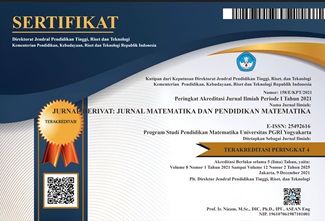Penerapan Model Think Talk Write Berbasis Multimedia Terhadap Kemampuan Pemahaman Konsep Dan Komunikasi Matematis
DOI:
https://doi.org/10.31316/j.derivat.v6i2.502Abstract
Abstract
TTW learning model assisted multimedia was applied to help students in developing their conceptual understanding and mathematical communication skills. This research was conducted to determine whether there was difference of effect between the application of TTW model assisted multimedia and peer tutoring model on the two mathematical skills. This research was a quantitative research with nonequivalent posttest-only control group design. The research population were the students of XI MIA at MAN 1 Pekalongan 2018/2019. The research sample was obtained by cluster sampling technique. The method used in collecting the data was a test. The data were analyzed by using the multivariate and univariate average difference test. The research results showed that (1) based on multivariate analysis, students’ conceptual understanding and mathematical communication skills that was taught by using TTW model assisted multimedia was different with students who were taught by using peer tutoring model; (2) based on univariate analysis, students’ conceptual understanding skills that was taught by using TTW model assisted multimedia was different with students who were taught by using peer tutoring model, and students’ mathematical communication skills that was taught by using TTW model assisted multimedia was different with students who were taught by using peer tutoring model.
Â
Keywords: TTW, Multimedia, Conceptual Understanding, Mathematical Communication
Downloads
Published
Issue
Section
Citation Check
License
Authors who publish with this journal agree to the following terms:
-
Authors retain copyright and grant the journal right of first publication with the work simultaneously licensed under a Creative Commons Attribution-ShareAlike 4.0 International License that allows others to share the work with an acknowledgment of the work's authorship and initial publication in this journal.
- Authors are able to enter into separate, additional contractual arrangements for the non-exclusive distribution of the journal's published version of the work (e.g., post it to an institutional repository or publish it in a book), with an acknowledgment of its initial publication in this journal.
- Authors are permitted and encouraged to post their work online (e.g., in institutional repositories or on their website) prior to and during the submission process, as it can lead to productive exchanges, as well as earlier and greater citation of published work (See The Effect of Open Access).







